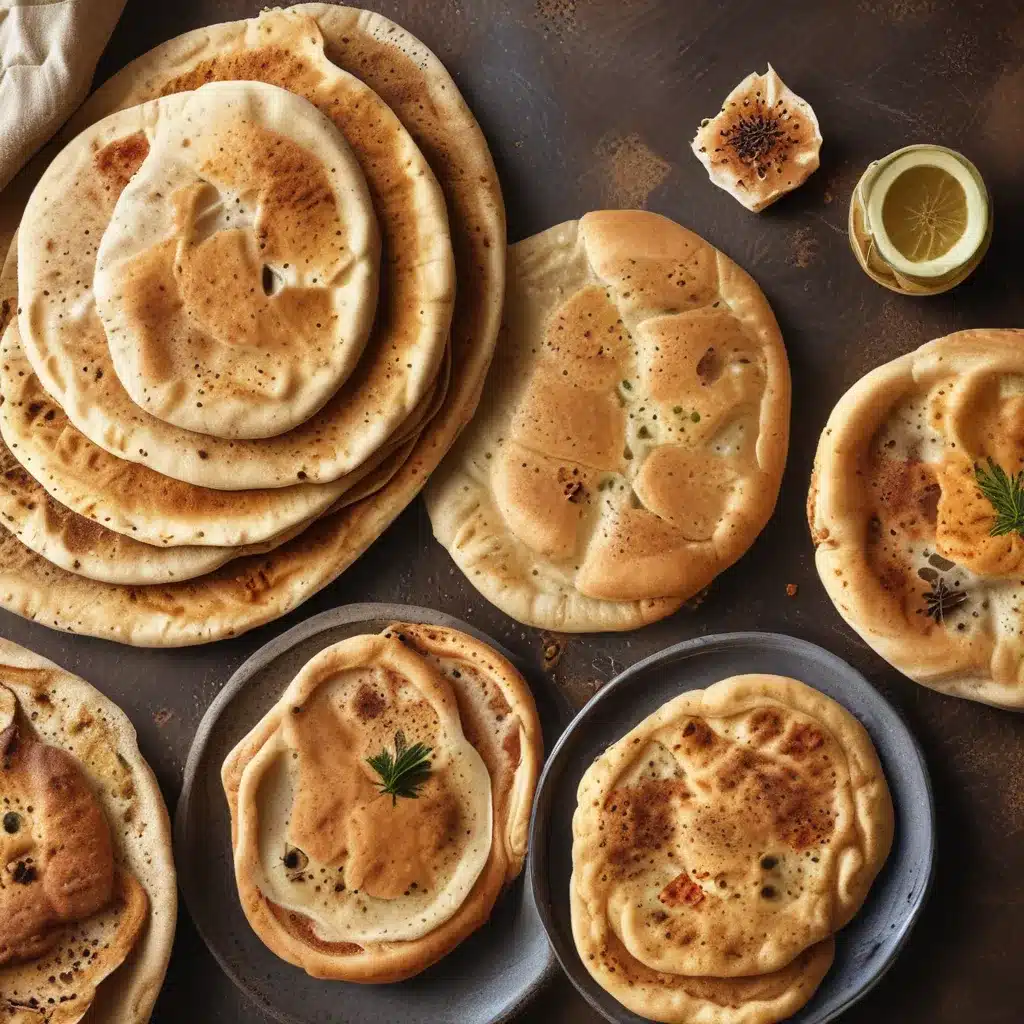
The Breads of Morocco: Flatbreads, Pancakes & More
A Culinary Journey Through the Diverse Breads of the Maghreb
As I stroll through the bustling streets of New York City, the aroma of freshly baked bread wafts through the air, beckoning me to explore the rich culinary heritage of Morocco. From the flaky, buttery layers of msemmen to the pillowy softness of khobz, the breads of this North African nation are a true delight for the senses.
For many years, I’ve been fascinated by the endless variations of yeast-free, yogurt-based flatbreads that are a staple in Moroccan cuisine. These versatile creations, sometimes called “yeast-free naan,” follow a simple formula of yogurt, flour, salt, and a touch of fat. The transformative magic happens when the dough is kneaded, left to rest, and then rolled and cooked to perfection.
As I discovered on Smitten Kitchen, the key to elevating these flatbreads lies in the layering technique. By brushing the dough with oil, sprinkling it with scallions (or other flavorful fillings), and then rolling it into a tight spiral before cooking, the dough develops delicate, flaky layers that puff up beautifully when pan-fried.
Exploring the Diverse Breads of Morocco
But the breads of Morocco extend far beyond the simple yogurt flatbreads. As I delved deeper into my research, I uncovered a rich tapestry of traditional breads that showcase the country’s culinary ingenuity and regional variations.
One such bread that caught my attention is the msemmen, a flaky, buttery layered flatbread that is a beloved staple in Moroccan households. According to The Perfect Loaf, the secret to mastering msemmen lies in the delicate dance of rolling, folding, and resting the dough, which results in those tantalizing, paper-thin layers.
Another intriguing Moroccan bread is the khobz, a fluffy, yeasted flatbread that is a cornerstone of the Moroccan diet. As Marocmama shares, khobz can take on various forms, from the traditional round loaves to the long, oblong shapes that are perfect for scooping up fragrant tagines and rich stews.
But the Moroccan bread repertoire doesn’t stop there. Delicate pastries like rghaif, which resemble flaky, buttery croissants, and the savory-sweet harcha, a cornmeal-based flatbread, are just a few more examples of the diverse and captivating breads that have emerged from this culinary powerhouse.
Mastering the Art of Moroccan Bread-Making
As I immersed myself in the world of Moroccan breads, I couldn’t help but be struck by the intricate techniques and precise attention to detail that go into their preparation. It’s a true art form, one that requires patience, dexterity, and a deep understanding of the interplay between ingredients and environment.
Take the process of making msemmen, for instance. As The Perfect Loaf explains, the dough must be kneaded, rested, and then painstakingly rolled, folded, and rested again, all while maintaining the perfect balance of moisture and elasticity. It’s a dance of hands and dough, a symphony of technique and intuition.
And then there’s the khobz, the beloved Moroccan flatbread that requires a delicate touch to achieve its trademark pillowy softness. Marocmama’s detailed instructions reveal the importance of properly hydrating the dough, allowing it to rise, and gently shaping the loaves before baking to perfection.
As I attempted to recreate these Moroccan bread masterpieces in my own kitchen, I was humbled by the skill and patience required. It was a journey of trial and error, of learning to read the dough and trust my instincts, of celebrating the small victories and learning from the inevitable missteps.
Connecting with Culinary Traditions
But the true reward in this endeavor was not just the delicious, freshly baked breads that emerged from my oven. It was the sense of connection – to the generations of Moroccan bakers who had perfected these techniques, to the vibrant markets where the aroma of fresh-baked bread permeates the air, to the families who gather around the table, tearing into these pillowy creations with hands and hearts full.
As I sat down to enjoy my homemade msemmen, its buttery layers flaking apart with each bite, I couldn’t help but feel a deep appreciation for the rich culinary heritage that had inspired this dish. And with each subsequent batch of khobz, rghaif, or harcha, I found myself transported, if only for a moment, to the bustling streets of Marrakech or the charming medinas of Fez.
Embracing the Diversity of Moroccan Breads
In the end, my exploration of the breads of Morocco has been a revelatory journey, one that has broadened my understanding and appreciation of this remarkable culinary tradition. From the flaky, layered flatbreads to the pillowy, yeasted loaves, each Moroccan bread tells a story – of regional influences, cultural traditions, and the endless creativity of the human spirit.
As I reflect on this culinary odyssey, I’m struck by the realization that the breads of Morocco are not just sustenance; they are a tapestry of flavors, textures, and narratives that weave together to create a truly captivating gastronomic experience. And as I continue to experiment and explore, I know that there are countless more discoveries to be made, countless more stories to uncover.
So, the next time you find yourself in El Bahia Moroccan Restaurant in New York City, I encourage you to venture beyond the familiar and dive into the rich and diverse world of Moroccan breads. Savor the flaky, buttery layers of msemmen, the pillowy softness of khobz, and the delicate, sweet-savory notes of rghaif and harcha. Let these breads transport you to the vibrant heart of Moroccan cuisine, and discover the rich tapestry of flavors and traditions that lie within.


